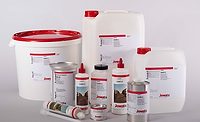Adhesives’ Role in Cross-Laminated Timber for Sustainable Construction
The eco-friendly trend towards the use of more wood in construction is one way the industry is responding to demands from consumers for more sustainable buildings.

Image courtesy of fotoVoyager / E+ via Getty Images
As with many aspects of economy, the construction industry is aware of and responding to demand from consumers to operate in a more sustainable way. The World Green Building Council recently published a report that “argues for systemic and integrated infrastructure solutions to improve sustainability outcomes.” According to the report, “The urban built environment alone is responsible for 75% of annual global GHG emissions, with buildings accounting on its own for 37%.”1 There are many elements within the construction industry that need to be addressed to improve its sustainability outcomes. Among those elements are the sustainable sourcing of raw materials and developing sustainable building materials that have a lower carbon footprint. The emerging trend towards the use of more wood in construction is one way the industry is responding to demands from consumers for more sustainable building practices.
An article published in the New York Times reports on the growing trend in Sweden and other Nordic countries towards larger buildings constructed of wood. According to the article, one of the major drivers in this trend is sustainability. Quoted in the article is Anna Ervast Oberg, a project manager at Folkhem, a real estate developer in Sweden that has committed to build new structures entirely from wood. Oberg told the New York Times that changing from a concrete structure to a wood structure results in a 50% reduction in emissions.2 Not only does sustainably sourced timber reduce the total greenhouse gas emissions from a construction project, but the wood in the building actually provides carbon storage.
 A wooden skeleton structure was constructed around the shopping, dining and event complex "Gare Maritime," using 10,000 m3 of wood. During construction, 3,858 tons of CO2 emissions were saved.
A wooden skeleton structure was constructed around the shopping, dining and event complex "Gare Maritime," using 10,000 m3 of wood. During construction, 3,858 tons of CO2 emissions were saved.
Christian Fild, head of Global Engineered Wood in the Adhesive Technologies business unit at Henkel, explained why construction will play a key role in climate change mitigation, “About 40 percent of CO2 emissions worldwide are caused by buildings. Eleven percent are generated by the construction itself, the other part is caused by the use of these buildings.” In total, concrete is the building material with the biggest carbon footprint because of the necessary production of cement. Additionally, there already are supply shortages for raw materials such as gravel and sand, which are other essential components of concrete. The industry is therefore looking for more sustainable alternatives – such as wood. Henkel's innovative adhesive solutions are contributing to this.
Fild explains that wood offers a benefit because it causes less CO2 emissions when produced. There are no blast furnaces or combustion plants used for wood construction materials. And, as mentioned earlier, while wood is in use, it acts as a carbon storage, binding CO2 from the atmosphere. Fild went on to explain, “Construction companies are starting to design buildings that can be taken apart and reprocessed. Large floor or wall elements, for example, are reused as construction products or furniture panels, which in turn can one day be made into chipboards. At the very end, after ideally more than 100 years of use, the wood will be thermally recycled. This is referred to as cyclical timber management.”
One reason wood has emerged as a preferred resource in construction, replacing concrete and steel, is due to new technology that has developed over the last 20 years. Fild outlined this new technology, “If you look at old half-timbered houses, you can see that the buildings last for a very long time, but after a while they become a bit crooked and deformed because the wood is constantly changing. About 20 years ago, cross-laminated timber was ‘invented.’ The multilayer solid wood panels provide a very high load-bearing capacity and stability. Even more interesting is the fact that wood is more suitable for constructing prefabricated buildings compared to steel and concrete. When you use wood, it can be prefabricated in factories and then simply be assembled at the construction site. You can manufacture much more precisely in factories than you could on site, which means that fewer errors occur. Instead of taking two months to build on site, a wooden building can therefore be completed in two weeks. This also results in significant cost savings.”
 The Pulse, located in Saint-Denis, France, is a hybrid wooden building combining the benefits of both concrete and wood.
The Pulse, located in Saint-Denis, France, is a hybrid wooden building combining the benefits of both concrete and wood.
Henkel’s Global Engineered Wood business started as a small, independent business 25 years ago, and was later purchased by Henkel. As the cross-laminated timber market was beginning to emerge, the industry looked for suitable adhesives for the application. In response, Henkel launched a polyurethane adhesive for wood bonding that as proven to be well suited for wood construction, and this innovation spurred the growth of the Global Engineered Wood division, especially in the last eight years.
Fild explained the specifics of this technology, “Our formaldehyde-free polyurethane adhesives were the first ones to meet the high standards for load-bearing wood construction. Adhesives containing formaldehyde work very well, but they are also carcinogenic, which is why they are used less and less. Henkel has made a really great contribution by enabling formaldehyde-free bonding in wooden construction. Another special feature is that you can manufacture very quickly, precisely, and neatly with Henkel's adhesives as they are great for constructing prefabricated buildings.”
Looking forward, Fild sees Henkel’s adhesives as one part of the global response to climate change. “We see wooden construction as a huge opportunity in terms of sustainability. I can also put it the other way around: Without wooden construction, the climate targets cannot be met. We at Henkel want to contribute to this as best we can. In the adhesives business, as it is often the case, we can only contribute a very small part, but the technology enables the bigger picture.”
Learn more at www.henkel.com.
References:
- Bringing embodied carbon upfront. World Green Building Council. https://worldgbc.s3.eu-west-2.amazonaws.com/wp-content/uploads/2022/09/22123951/WorldGBC_Bringing_Embodied_Carbon_Upfront.pdf
- Leigh, G. (2021 July 30). Wooden Buildings Reach for the Sky. New York Times. https://www.nytimes.com/2021/07/30/todaysinyt/wooden-buildings-reach-for-the-sky-in-vaxjo-sweden.html
Article images courtesy of Henkel.
Looking for a reprint of this article?
From high-res PDFs to custom plaques, order your copy today!









